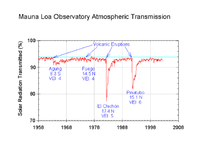
Photo from wikipedia
In this study, fast climate system responses to CO2, aerosols and sulfate aerosols are studied based on simulations of Coupled Model Inter-comparison Project Phase 5 (CMIP5) atmospheric models. We demonstrate… Click to show full abstract
In this study, fast climate system responses to CO2, aerosols and sulfate aerosols are studied based on simulations of Coupled Model Inter-comparison Project Phase 5 (CMIP5) atmospheric models. We demonstrate that the fast climate adjustments caused by CO2 forcing lead to decreases in global annual mean cloud fractions, evaporation and precipitation and to increases in the global annual mean net radiative forcing and atmospheric water vapour content. The inhibition of rainfall is primarily caused by the reduced oceanic precipitation. Regionally, Africa, South Asia, East Asia and Australia exhibit pronounced increases in rainfall, which are presumably attributed to the strengthened summer monsoon caused by the increased land–sea thermal contrast. Aerosols and sulfate aerosols exhibit only a slight effect on the global hydrological cycle before global surface temperature changes. However, by affecting the land–sea thermal contrast, they can have profound effects on regional-scale hydrological cycles, such as those over southern Africa, South Asia and East Asia in the boreal summer. Moreover, the cloud fast feedback under the aerosol forcing is highly associated with the way of dealing with aerosols in the atmospheric model.
Journal Title: International Journal of Climatology
Year Published: 2017
Link to full text (if available)
Share on Social Media: Sign Up to like & get
recommendations!